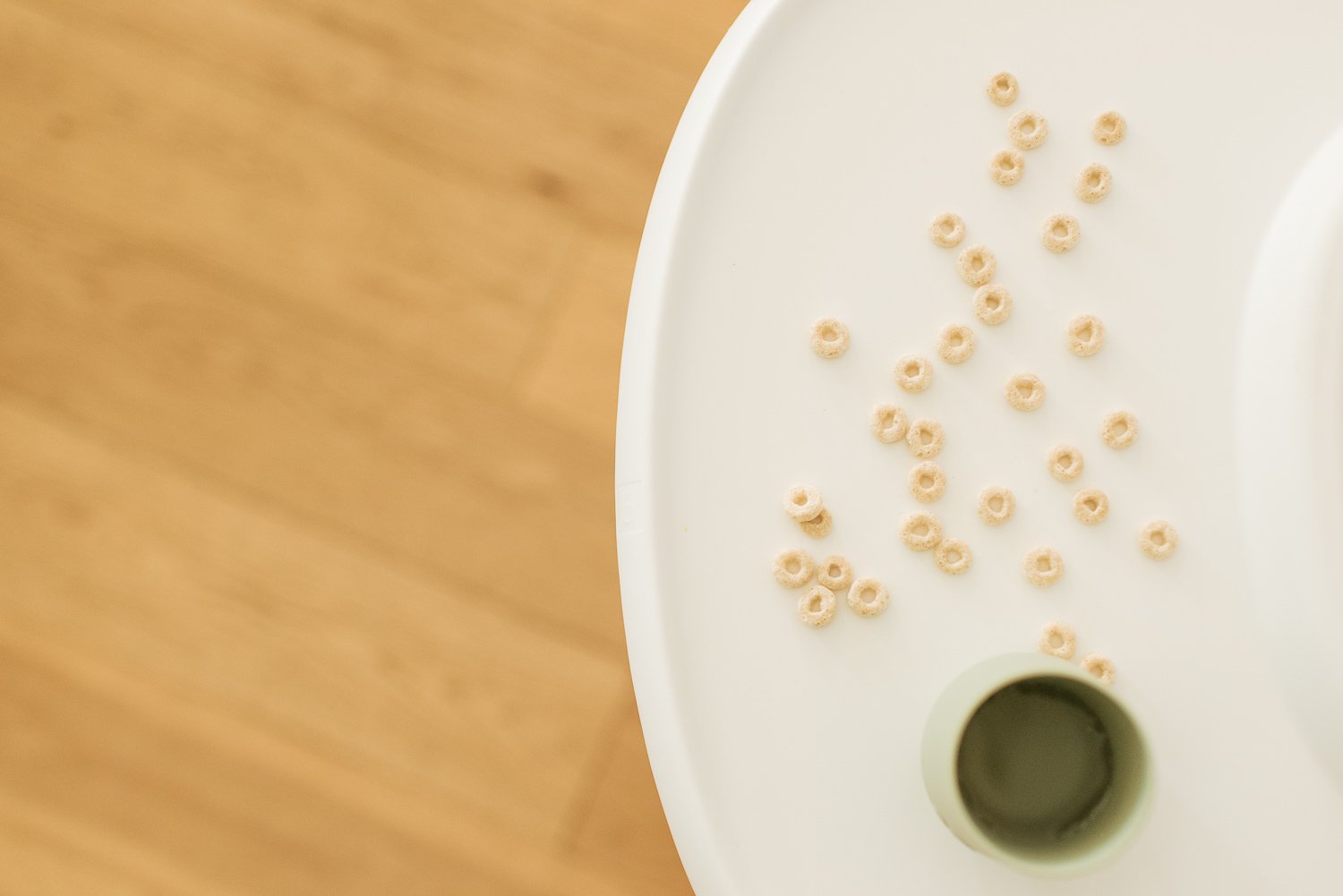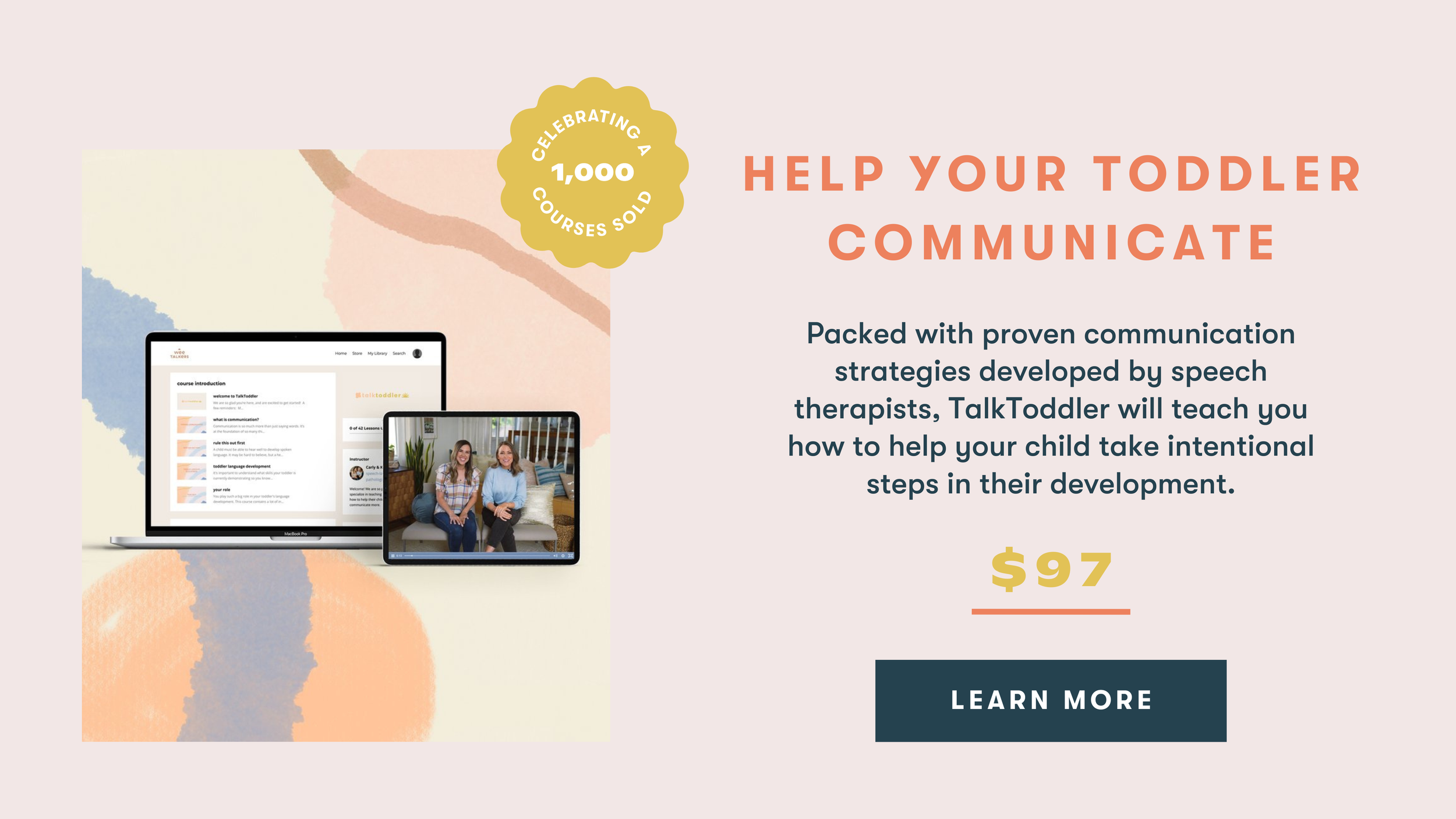Sign Language for Toddlers
Most of the families we see in speech therapy are working towards having their littles ones communicate verbally. So often, there’s a common misconception that using non-verbal communication, like sign language, will set them back by either preventing toddlers from communicating verbally, or by even causing a delay. Thankfully, as speech therapists, we can confirm (and prove with research) that this is not the case! If your toddler isn’t speaking yet, sign language is a step in the right direction. One that can help them and you until they’re ready to communicate with words.
This post is your guide to sign language for toddlers: What it is, why it’s beneficial, and how to teach it to your little one. We’ve even answered common FAQs like “Do signs count as words?” and “Should I correct my toddler’s signs?” We hope this guide will be all the information encouragement you need to start using sign language with your toddler!
What Is Toddler Sign Language?
Toddler sign language (also called “baby sign”) is a system of gestures and simple signs that are easier for toddlers to copy and say than words are. This is because the movements needed to produce signs are much simpler than the complex fine motor movements required to speak!
In this post, we’re focusing on how to help your toddler learn some sign language as a means to get them talking and communicating with you more. Speech-language pathologists will sometimes use a little bit of sign language in this way as a mode of communication for children who are not yet communicating verbally. The signs we pick are based on the child’s individual needs, and we don’t necessarily focus on children using the signs perfectly. And, we definitely don’t consider ourselves sign language experts! We just use signing as a tool—a bridge to communicating a word or concept with your child.
The Difference Between ASL AND Baby Sign
We love sign language, so we want to recognize right off the bat that American Sign Language (ASL) is something very different from the type of sign language we’re teaching you to use with your littles. ASL is its own language with its own grammatical structure. And it’s not what we’re referring to here! If you’re interested in learning or teaching your child ASL, we recommend learning from Deaf educators, and other specially trained educators for the Deaf.
Bottom line: Both ASL and toddler sign language are useful means of communication, but they’re definitely not the same thing!
Why Sign Language Is Good For Toddlers
Speech is a complex, developmental skill set. It builds up over time, as your child masters the smaller, foundational steps that lead to them speaking—when they’re ready. Because it’s so complex and takes time, often young children can understand and communicate more words and concepts than they can actually say. Sign language and other types of augmentative and alternative communication (AAC) can facilitate communication with your child before and until they can speak to you.
It’s also important to know that there is so much more to communication than speaking. Some children never speak, but their communication is so rich in other ways! So if your toddler is having difficulty communicating verbally—or if they’re not but you want to be proactive—we highly recommend incorporating sign language into your routine. There’s really no downside, and you’ll feel great knowing you’re helping to build their communication skills!
The Benefits of Toddler Sign Language
There are so many benefits to sign language for toddlers! Beyond helping your toddler communicate certain things with you before they start to speak, toddler sign language:
Decreases toddler frustration (It’s so hard when no one understands!)
Adds a visual component to language (which can help with understanding)
Adds another learning modality to communication
Simplifies the motor movements required to communicate
Can be a stepping stone on the path to verbal communication
Can Toddler Sign Language Delay Speech?
No, toddler sign language does not cause a speech delay. You can rest easy!
A message we want to share with all parents is that toddlers aren’t lazy when it comes to communication. They always do the best they can with the abilities they have. Toddlers also do what is easiest and fastest. And when it comes to communicating, talking is always going to be the fastest. So when kids can talk, they do! Remember that speech requires many precise fine motor movements, so if they’re not speaking yet, it’s very likely that they do not have the ability to yet. Toddler sign language won’t cause or further a delay—it’s a step in the right direction!
When you’re incorporating toddler sign language, ALWAYS model spoken language with the sign and encourage any and all vocalizations! Even if it doesn’t match up with the word perfectly. So if you’re singing ‘more’, say “more,” too. And encourage them when they communicate back, even if what they say sounds like “mmm” or “mo”. It’s all progress!
Related: Help! My 18-Month-Old Isn’t Talking Yet
Related: Signs of Speech Delays in Toddlers
The Best Age for Children to Learn Sign Language
The best age to start sign language is the age your child is now! There’s no wrong time to start, and there’s no such thing as too late. Children can start to pick up sign language very early on—even as babies!—but you definitely haven’t missed the boat if you haven’t started yet. 6-9 months is a really nice time to start if you have the ability to choose. But again, we want to emphasize that it’s definitely not too late if your baby is 1 or 2 years old.
How To Teach Your Toddler Sign Language
We know that teaching your toddler sign language might sound like a big endeavor! But even aiming to teach a handful of signs can be really beneficial for your toddler AND for you.
To begin, decide on a few signs that you’ll start with. (One to three is great!) And remember, this is all new for you as a parent, too, so give yourself grace and time to figure things out.
Tips for Teaching Your Toddler Sign Language:
Match the sign with what’s happening at the moment (E.g. ‘Milk’ if it’s milk time, ‘shoes’ if it’s time to go, ‘eat’ or ‘more’ if you’re giving more food during mealtime).
Show them the sign and say the spoken word along with it.
Don’t expect them to copy what you’re doing right away, especially in the beginning! Remember, just like when learning words, kids need a lot of repetition with signs. Make sure you’re modeling the signs A LOT before you expect them to sign back.
Notice and respond to any non-verbal messages your child sends you. These don't have to be sign language exactly—anything that shows they’re interacting with you is great. You can also use natural gestures like nodding your head for “yes” and “no” to support your little conversation!
Correcting Your Toddler’s Sign Language
As we mentioned above, your toddler might not sign back right away. But you need to know that when they do start to, they also won’t sign perfectly. This is common and it’s totally normal!
Our advice is not to stress at all about the sign looking perfect. Remember, our goal isn’t to make them fluent in ASL, it’s to get them communicating in their first language! So celebrate their attempts and don’t worry about correcting.
Pro Tip: Some signs are hard for littles. Don’t be afraid to simplify! You can even make up your own way of doing it—something that works better for you and your baby. My daughter and I had our own variation of “water”!
Best Signs to Teach Toddlers
#1 Signs That Match Their Interests
Look at your toddler’s interests! Do they love playing with a ball, a truck, or animal toys? Are they fascinated by the family dog or cat? Things they’re naturally drawn to are great first signs, because you’ll know going in that they’ll learn to communicate something that’s important to THEM!
#2 Signs That Meet Needs
You can also prioritize signs that help your child get their needs met. “All done” is a good one.
(How nice would it be if they could sign “all done” instead of having to scream to get out of a high chair?)
#3 Routine-Based Words
We also like incorporating signs into daily routines, because you know that repetition will naturally happen, and because they’re already tied to concepts that are likely familiar to your child. This is why starting with signs like bath, diaper changing, and meal time can be really meaningful!
Toddler Sign Language FAQs
#1 Does Sign Language Count As A Word?
Yes! Because they’re using language to communicate with you, any signs your child knows and uses consistently count as words.
Related: How Many Words Should My Toddler Be Saying?
#2 Does Signing Decrease Interest In Talking?
No, research shows that toddler sign language helps kids communicate, and that it won’t prevent them from speaking.
#3 My Child Uses The ‘More’ Sign For Everything. HELP!
This is very common! They see that ‘More’ has the power to make things happen, and that’s a good thing. We want them to know that their communication has power. But we know it can get a bit frustrating for you!
Tip: Try modeling a lot of other signs, too! Parents often model “more” a lot, so it becomes a go-to. If you can, introduce other words they show interest in.
Sign Language & Toddler Communication Milestones
We love sign language for toddlers. It’s a fantastic step on their path to communicating verbally, and we know that it won’t cause a delay! We highly recommend toddler sign language if your toddler is not meeting speech and language milestones!
Get Our Toddler Talking Milestones Checklist
Starting to wonder or worry about your toddler’s language development? The best first step you can take is to learn the toddler language milestones. This way, you can clearly see which skills they’ve mastered, which ones they’re working on, and what’s coming next.
Before you go, make sure to download a free copy of our toddler milestones checklist! You’ll love how clear and easy it is to follow.



